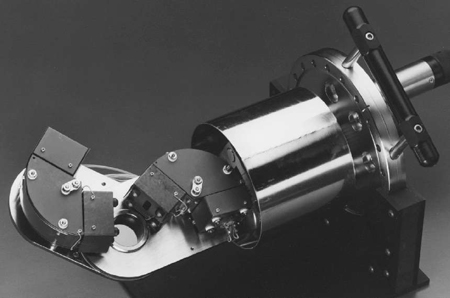An Introduction
High-resolution electron energy loss spectroscopy (EELS) is a high-sensitivity, non-destructive technique for the study of surface and adsorbate vibrations and low-energy electronic excitations.

The high-sensitivity (< .1% of a monolayer) and broad spectral range (0-1,000 meV, 0-8000 cm-1) make EELS an ideal tool for exploring the properties of a wide variety of surfaces. These include (but are not limited to) single crystal metals, semiconductors and insulators, evaporated films, polycrystalline foils, and polymers. At present, resolution is limited to 4 meV (32 cm-1) depending on the scattering properties of the surface under study.
Because of the compact size of the McAllister Technical Services' Spectrometer, EELS can be readily combined with a variety of other surface sensitive probes, including low-energy electron diffraction (LEED), Auger electron spectroscopy (AES), both X-ray and ultraviolet photoelectron spectroscopy (XPS and UPS), and temperature programmed desorption (TPD), to provide a complete description of the structure and bonding of adsorbed surface species.
Applications of high-resolution EELS include fundamental studies of molecule surface interactions, catalytic reactions taking place on oxide-supported metal clusters, corrosion of metal surfaces, and reactions at the solid-liquid interface.
In principle, high-resolution EELS is a very simple technique. Electrons are boiled off of a hot tungsten or LaB6 filament and focused onto the entrance slit of an electrostatic energy analyzer by a three element Einzel lens. The electrons are then monochromatized at low pass energy in a 127 electrostatic sector and accelerated and focused onto the sample by another set of lenses. Typical incident beams energies and currents are 5 eV and 2x10-10 amp, respectively. The scattered electrons are decelerated by another set of lenses and focused onto the entrance slit of the analyzer sector. The energy distribution of these electrons is then measured by scanning the analyzer in a retarding potential ("window") mode. Electrons are finally detected by a channel electron multiplier. The signal is amplified, counted, and recorded outside of the vacuum system.
The many subtleties in the design of McAllister Technical Services' Spectrometer and its associated electronics allow it to operate with excellent resolution and high count rate.
Of equal importance is its ease of tuning and high stability (reproducibility). High-resolutions EELS experiments can be run in a variety of ways, depending on the type of information required. Low-energy electronic excitations or surface phonons intrinsic to a clean metal or semiconductor surface may be readily studied.
Alternatively, the sample may be dosed with a gas at a given temperature and the vibrational spectra of the adsorbed species recorded. Scanning spectra as a function of surface temperature or experiments in which the sample temperature is quickly raised to a given value and then rapidly quenched (to record the vibrational spectra of meta stable surface intermediates) are also feasible. Even experiments involving following the spectral evolution of adsorbed species as a function of time or temperature can be readily performed.
The flexibility of the McAllister Technical Services' High-Resolution Electron Energy Loss Spectrometer allows the researcher to choose from a wide variety of experimental possibilities. Please contact us for a discussion of your application.